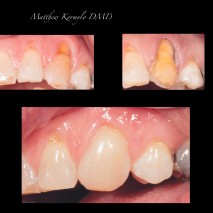
Notice the deep dark colored neck area of the canine tooth below. Tooth colored filling material is often used in areas such as this to protect the vulnerable unprotected surface void of enamel. Little notches near the necks of teeth are very common and are not always associated with grinding habits. Often sensitive to cold and difficult to clean, these defects lead to gum recession as illustrated clearly here. Gum surgery has become a very predictable way to recover receding gums but in this case, surgery was not needed. The underlying cause of this defect is primarily excessive teeth grinding placing extreme lateral forces against the tooth. These forces can cause the tooth to flex – which stresses the bone and soft tissue supporting the tooth. 
What has been discovered in more recent literature, tooth flexure increases when enamel loss reaches moderate levels. Ceramic is in many ways very similar to enamel structurally and when used appropriately can reduce this flexure resolving problems arising peripheral problems. Notice the photo progression of treating this tooth using a ceramic veneer to cover the visible surface of the tooth. The tissue recovery here is a remarkable observation of what happens to tissue when flexure is reduced back to ideal levels. Surgery was completely avoidable here for this patient.





